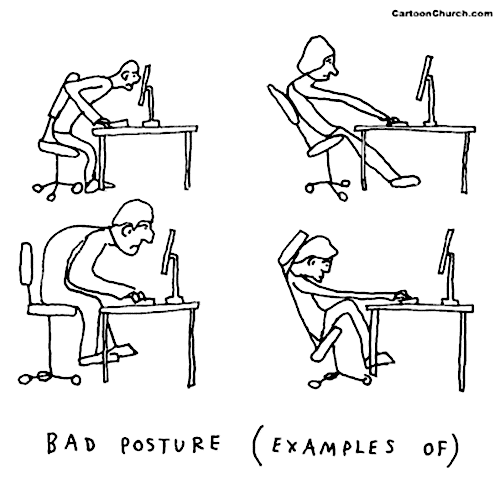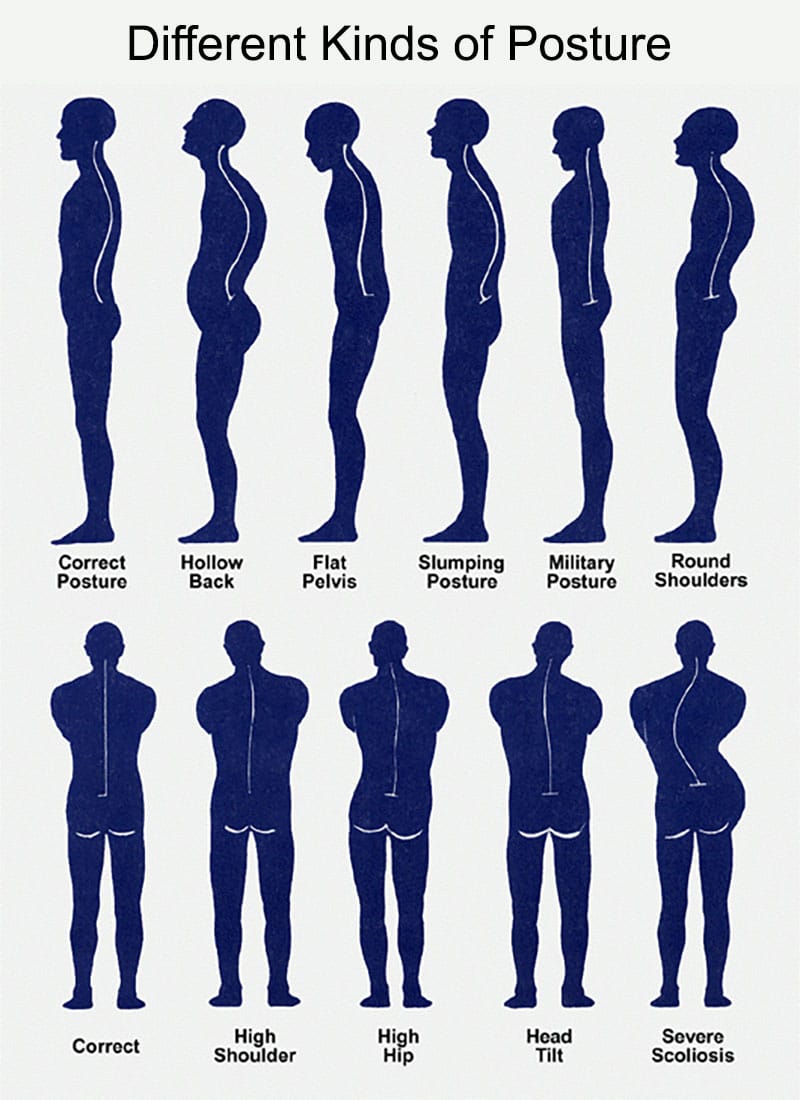
(Image: Cartoon Church)
Do you have a good or bad posture? As you are reading this, how is your posture right now? Are you sitting upright? Are you slouching your back? Have you totally sunk into your chair?
When I was a small kid, I was very conscientious of keeping my back straight the whole time, because my parents and teachers were constantly reminding everyone to do so. My back was so straight that there was a time when my teacher commended on my posture and told the other students to follow me as an example, much to my embarrassment.
However, things changed when I was 15, where I had my own computer and started spending copious amount of time in front of it. My posture became pretty bad. I would generally alternate between slouching over my desk, curling my whole body into my chair or sinking into my seat. It was as if my spine turned into jelly. The fact that I was (still am) taller than most girls around me (I’m currently 5′ 7″ (170cm), 4 inches taller than the average Singaporean girl at 5′ 3″ (160cm) ) didn’t help me in maintaining a good posture too.
Initially I didn’t care too much about improving my posture, because I figure I could just switch back to a good posture whenever needed. However, after a few years, I began to recognize the value of maintaining a good posture at all times.
Why Have a Good Posture?
There are 5 key benefits from maintaining a good posture.
- Facilitates breathing: A good posture naturally enables you to breathe properly. I started appreciating this after I started meditating regularly a few months back, coupled with a good posture. I found a really a huge difference in the amount of air I could inhale between sitting up straight and slouching. This is why yoga, pilates and meditation exercises pay so much attention on getting your posture and sitting positions right.
- Increases concentration and thinking ability: When you are breathing properly, you increase your thinking ability too. Our brain requires 20% of oxygen to do its job properly. More air, more oxygen. More oxygen, more brain food. More brain food leads to more thoughts and ideas.
- Improve your image: People with good postures look smarter and more attractive. Have you ever seen someone with a bad posture and felt the person seemed unkempt, even though the person has not said or done anything yet? On the flip side, someone with a good posture naturally exudes an aura of assertiveness and appeal.
- Feel even better about yourself: When you have a good posture, it helps to make you feel more self-confident, without even doing anything else different. Try sitting in a bad posture now for 30 seconds. Now, switch to a good posture for 30 seconds as well. Is there any difference in how you felt?
- Avoid health complications: A bad posture results in several complications over time, such as increased risks of slipped disc, back aches, back pain, pressure inside your chest, poor blood circulation. When I was studying at business school, I had a professor back who suffered from a slip disc when he was younger. Unfortunately, he can’t straighten his back ever since the incident and he now walks with a permanent slouch.
So, What Is A Good Posture?
Contrary to popular belief, a good posture does not mean keeping your spine totally straight. I used to have that misconception and it deterred me from keeping a good posture since it was just so tiring having to keep my back so straight all the time. If you feel it is exhausting whenever you try to maintain a good posture, it’s probably because you are trying to keep your back fully straight. Trying to keep your back/spine fully straight is actually as detrimental to your back as a slouched posture. By constantly tightening your back muscles, you end up straining it in the process.
A good posture means maintaining the two natural curves at your back – (1) the concave curve from base of your head to your shoulders and (2) the concave curve from your upper back to the base of your spine. It’s like the shape of 2 C’s on your back. Refer to left-most posture below:

(Image: Mr. E)

(Image: Mr. E)
When you are in the right posture, it should feel almost effortless to maintain the position. When you stand, your weight of your body should be evenly distributed across the balls of feet (not the heels or the front).
Take a minute out now and examine your current posture in front of a mirror (full-length if possible; otherwise get one that allows you to see at least the upper half of your body). Does it fit the description of a good posture? If not, spend a few seconds to adjust your posture to the right one before you continue to read the article :)
How to Improve Your Posture
Here are 13 tips which can improve your posture and keep it that way. I’ve tried all of them (except #13, since I don’t have back problems) and they work great in maintaining a good posture for me.
- Identify your key motivation for having a good posture: Why do you want a good posture? Is it to improve your breathing? To boost others’ perception of you? Feel more confident about yourself? To avoid health problems? Be clear on your underlying desire so you can remind yourself of it whenever you feel lazy to do anything about your posture.
- Pretend your body is held by a string: This is an analogy I read somewhere before which I find helpful. It might sound weird, but it’s pretty effective. Pretend that your spine and head is held up by a string from the ceiling all the time. If you are lying down, pretend the string is held in a direction parallel to the ground. Focus on keeping your spine and head aligned with the string while relaxing other parts of your body. Usually people end up tensing all other parts of their body when trying to keep a right posture. What this does is it keeps you focused on keeping your back straight and loosening your other muscles.
- Set a reminder to check in on your posture: Many of us may have the intention to keep a good posture, but we usually forget about it after like 5 minutes! A reminder in the form of a post-it note, item in your calendar, alarm, etc definitely helps. The frequency is up to you, from once a day to as frequent as every 15 minutes. With sufficient reminders, you will start kicking into a good posture naturally soon.
- Get a head, shoulder and back massage: If you have always been in a bad posture, you will find that it’s hard to change your posture due to the hardening of your joints. I found that getting a massage loosens up my joints, which makes it easier for me to get into a better posture afterward.
- Eliminate bad habits that cultivate bad postures: This includes watching TV/reading while lying down, working under dim light (which results in slouching), sleeping on your stomach (apparently 7% of people do that!).
- Get a good quality chair: A good chair will be one that has a sufficiently firm and dense cushion with back support. For me, I prefer the back of the chair to run up to at least my shoulders so I can place them against it.
- Place your butt at the innermost edge of the chair: This seemingly benign tip actually helps set the right base for your posture. Many people have bad postures because they place their butt on the middle or towards the end of the chair. This causes them to lean/slouch forward and hunch since there is no support behind their backs to press against.
- Get a back cushion: This was pretty effective for me when I first started improving my posture. Buy a seat cushion and put it at the back of your chair. Whenever you sit, make sure your back is wedging the cushion against the chair. Whenever you lean forward, the cushion will fall down, which will act as a reminder to shift back into your proper posture.
- Ground both your feet when standing or sitting. This means having both feet planted flat on the floor and not resting your weight on a particular foot, which is a very common habit. While sitting, try not to cross your legs. This helps to keep the upper part of our body straight.
- Invest in a good bed and pillow: Get a mattress that is firm and not too soft. The soft mattresses where you sink into may feel nice and comfy initially, but is not good for your back/posture. In the hotels I’ve stayed in before for my past business trips, some of the hotels had really soft mattresses and pillows which just left my back and neck aching in pain the next day!For your pillow, consider investing in an orthopedic pillow. There are quite a few different designs in the market now. The most common is contour pillows, which are pillows that arch and support your head – I have been using one since I was 17. Another type is the neck pillow, a horse shoe shape pillow which is great for traveling.
- Avoid carrying heavy items: Just the act of carrying heavy items is bad for our shoulders and back. Attempting to do so over an extended period of time gradually leads to hunched shoulders and backs. If you are a student, you probably do this every day with all the books for classes. For professionals, it might be your laptop and work materials which you have to lunge around to and fro. If it’s not possible to reduce the load of things you carry around, you can consider getting a trolley bag or roller bag – these are really convenient and are becoming common place.
- Engage in exercises which strengthen your back: These include pilates, yoga, exercise balls and simple stretching. If you do sit-ups or crunches, ensure you are using the right technique (click on the link for more details) – otherwise, you will end up hurting your back instead.
- Get a professional assessment: If you have an extremely bad posture and a history of back injuries or back aches, it will be good to visit a chiropractor or physical therapist for a professional assessment. He/she can advise you on how to better take care of your back.
Today, I’m back to having a good posture, be it when exercising, using the computer, sitting, or walking. Try the tips out for yourself as you work on improving/maintaining your posture and see if they work for you. :)
This is part of the Cultivate Good Habits Series. Check out the full series:
- 21 Days To Cultivate Life Transforming Habits
- Waking Early: 9 Reasons To Wake Up Early | 21 Tips To Wake Up Early
- Quitting Soda: 5 Reasons To Quit Drinking Soda (And How To Do It)
- Improve Your Posture: Benefits of a Good Posture (And 13 Tips to Get One)
- Be TV-Free: 10 Reasons You Should Stop Watching TV
- Being On Time: How To Be On Time
- Meditation: 10 Reasons You Should Meditate | How To Meditate in 5 Simple Steps
- Manage Emails Effectively: How To Manage Your Emails Effectively
- Run Barefoot: 10 Reasons To Run Barefoot
- Emotional Eating: How To Stop Emotional Eating (6-part series)







 Thanks for reading. If you like my free articles, join my private email list and get my latest updates and articles sent right to your inbox.
Thanks for reading. If you like my free articles, join my private email list and get my latest updates and articles sent right to your inbox.